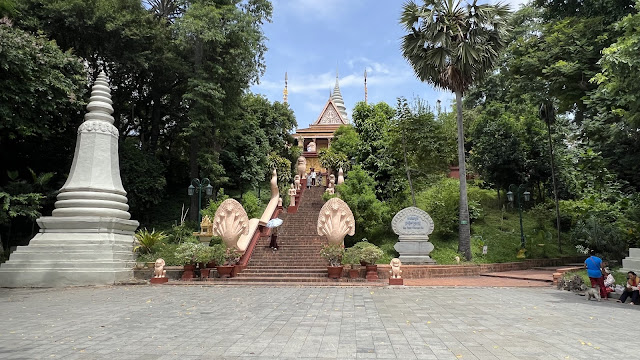In the past (1372 CE), there was an elderly woman named Daun Penh who was very wealthy and lived near the banks of the Four Faces. Her house was built on a small hill on the eastern side of a mountain. One day, there was heavy rainfall and the river overflowed rapidly. Daun Penh went down to the riverbank and saw a large koki (kelp) tree floating near the shore. Because of the strong current, the tree kept swirling and drifting near the riverbank. When Daun Penh saw this, she quickly called on her neighbors to come help pull the tree out of the water. The neighbors tied ropes to the tree and slowly dragged it to the shore.
At that moment, Daun Penh took a piece of wood to scrape off the mud and discovered inside the hollow of the koki tree four small bronze Buddha statues and another stone statue of a deity. The deity was standing, holding a staff in one hand and a conch shell in the other, with a topknot on its head. Daun Penh and the neighbors were overjoyed to have found these sacred objects and carried them in a procession to Daun Penh’s house. She arranged to have a small hut built to house the statues temporarily.
The next day, Daun Penh asked the neighbors to help raise the land on the hill to the west of her house, turning it into a proper mountain. After that, she had the koki tree cut down to use the wood to build the pillars for a temple she intended to construct on the mountain.
In 1372 CE, Daun Penh and many villagers came together to build a small temple with a thatched roof at the top of the mountain. They enshrined the four bronze Buddha images inside the temple. As for the stone deity, she placed it on a platform at the foot of the eastern side of the mountain. Believing that the statue had floated from Laos and resembled a Laotian figure, she gave it the name “Nek Ta Preah Chao” — a name that has lasted to this day.
Behind the pagoda stands an ancient stupa that houses the relics of King Ponhea Yat (the king who abandoned Angkor in 1431 CE). Tourists cannot leave this place without visiting the memorial stupa that reminds us of these lands during the Second World War. This memorial is located on the southern side of the mountain.
This mountain is covered and surrounded by tropical trees representing different regions and sectors that have taken root across the country. These trees have become a refuge for monkeys and many birds, especially large hornbills that perch among the branches.
After the temple was completed, Yay Penh invited monks to settle at the foot of the mountain, on the western side. The place was named “Wat Phnom Daun Penh,” which has since been shortened to simply “Wat Phnom,” a name that remains to this day.






No comments:
Post a Comment